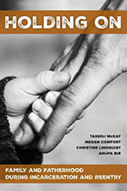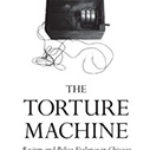Holding On: Family And Fatherhood During Incarceration And Reentry

Authors: Tasseli McKay, Megan Comfort, Christine Lindquist, Anupa Bir
Publisher: Oakland, CA: University of California Press, 2019. 224p.
Reviewer: Anne M. Nurse | September 2020
“Always having hope” is how Darren, an incarcerated father, describes parenting from prison in Tasseli McKay, Megan Comfort, Christine Lindquist and Anupa Bir’s excellent new book Holding On: Family and Fatherhood during Incarceration and Reentry. Darren’s optimism is surprising because there are many reasons people in prison might lose hope about family relationships. Contact with children and partners is difficult, and reentry poses a new set of challenges for family life. But McKay, et al. convincingly argue that, not only is there hope for these relationships, they are key to men’s successful return to society. In failing to recognize this, current policy subverts its own stated goals of lowering recidivism, increasing employment, and raising healthy kids. The book draws on extensive qualitative and quantitative data to address a number of essential questions about how imprisonment and reentry affect incarcerated men’s relationships with children and partners. The authors also explore factors that strengthen family ties and increase success in reentry.
While there have been other studies investigating the impact of incarceration on various aspects of family life, none have the breadth and sophisticated methodology of Holding On. The authors drew on data from the Multi-site Family Study on Incarceration, Parenting and Partnering. The original goal of this study was to measure the efficacy of government-sponsored demonstration projects designed to strengthen family ties. To qualify for the family strengthening project, men had to self-identify as being in an intimate or co-parenting relationship with a woman. The study participants were pulled from this pool and, once the men agreed to participate, their partners were invited to respond as well. Ultimately, 1482 couples were recruited and took surveys at least three times over a three-year period. For the purposes of program evaluation, surveys were also collected from a control group of incarcerated men and their partners. All of the initial interviews were conducted in prison, but most of the follow-ups took place in the community after the men’s release. To supplement the survey data, the study design included in-depth qualitative interviews with a subset of 166 people (both men and women) from the original sample. In most cases, these interviews were post-release, enabling both members of the couple to reflect on reentry experiences.
The unique and intensive data collection techniques allowed McKay, et al. to address the impact of incarceration on fathers’ relationships with children. Specifically, in Chapter Two, they consider whether patterns of co-residence, financial support, and shared activities change from before incarceration to after. Perhaps not surprisingly, participants reported lower levels of all three post-incarceration. At the same time, however, there was a substantial subgroup of men whose relationships with children held stable or improved over time. This outcome was most likely when men’s children were young. During in-depth interviews, fathers reported that they perceived older children to be more resentful of their incarceration and more resistant to letting them back into their lives. Another factor that predicted the maintenance of close relationships was in-person contact between children and fathers during incarceration. Finally, while previous studies have found that mothers restrict returning fathers’ access to children, this study identified a significant group who served as coaches and cheerleaders as men worked to reintegrate into their children’s lives.
In the third chapter, the authors turn their attention from men’s relationships with children to those with adult partners. Again, there was a deterioration over the period of incarceration and reentry, with fewer couples living together after incarceration, and assessments of relationship quality decreasing after men were released from prison. Many of the couples said that they found reentry to be difficult because they had to find new ways to relate to each other. For example, while the men were in prison, it was often easier to withhold information about negative events. This was an ineffective communication strategy, however, when both partners were living in the community. Relationships were also complicated by the difficulty men had finding employment and conflict between couples over parenting styles, sharing of chores, and monogamy. What distinguished the relationships that remained strong? They were longer in duration and involved co-parenting. When couples had close contact during incarceration, it helped them to navigate reentry. Sadly, however, the study revealed that the couples had high rates of abuse both pre- and post-incarceration.
One of the most interesting and innovative contributions of Holding On is its discussion of the predictors of post-release success. Historically, researchers and politicians have operationalized success based solely on recidivism. McKay, et al. argue that, while recidivism is important, returning citizens place importance on a much wider range of outcomes. In Chapter Five, the authors describe a multi-domain measure for post-release success that includes factors like the strength of family ties as well as employment and the avoidance of drug use. They find a complex pattern with different factors predicting each of the domains. Notably, pre-release employment, education, and substance abuse services appear to have a positive relationship with later employment. Parent/child contact in prison is even more important, significantly predicting success in employment, financial support for children, and family relationship strength.
Chapter Six focuses on the demonstration projects. While all four projects were designed to strengthen ties between incarcerated men and their romantic and/or co-parenting partners, the target populations as well as the delivery formats varied across the participating prison systems. This was a significant methodological weakness, making it virtually impossible to pin down which program elements were responsible for outcomes. While both Indiana and New York’s programs involved a weekend seminar/retreat for couples, Indiana’s project only included men residing on specialized faith and character units while New York’s was open to the general prison population. Ohio’s project was classroom based, involving 12 weekly meetings with incarcerated men and, when available, their partners. In New Jersey, men with chemical dependency problems and their partners were provided with a wide range of educational and support services both pre- and post-release. The study concluded that only Indiana’s program was associated with positive outcomes. For example, the participants were more likely than the control group to maintain strong relationships with partners and children, to find employment, and to desist from drugs. It is not entirely clear why Indiana’s program was more successful than the others, but in interviews, the participants expressed particularly strong and positive memories of the weekend. While they valued the educational components, they also remembered that the organizers made it special, with free hotel rooms for the women and fancy food and roses on the tables during sessions. Further research on these new types of family strengthening programs is warranted.
When reading Holding On, it is easy to get caught up in the fascinating findings. But some of the book’s most important contributions are methodological. For example, because both members of couples were interviewed, the authors were able to compare responses. This revealed significant disparities in reports of abuse as well as assessments of relationship quality, suggesting that studies of family dynamics that rely on information provided by only one partner are likely to contain bias. Another methodological contribution came from the author’s discovery that—despite extensive measures to protect confidentiality— some of the women believed that if they reported abuse to researchers, law enforcement would arrest their partners. This provides an important reminder that people who are involved with the criminal justice system are particularly vulnerable, impacting their willingness to be honest on surveys.
All of the chapters of Holding On conclude with policy suggestions. These range from increasing contact between incarcerated parents and children to providing long-term support services to returning citizens and their families. High rates of abuse in the population suggest domestic violence prevention is warranted, and that all policies have to be carefully crafted to protect abuse victims. The authors argue, however, that these kinds of new policy initiatives will be difficult to implement unless we acknowledge that criminals are more than the sum of their crimes. In other words, we must recognize that incarcerated people are parents and partners, or we end up creating counterproductive policies. An example are rules that automatically disqualify some categories of felons from living in public housing with their families. The fact that relationships have the potential to bring meaning and success in reentry should lead us to support, not tear apart, families.
Holding On is a must-read for policymakers and prison administrators. It is accessible enough for use in undergraduate and graduate sociology, policy, and psychology courses. It is also an invaluable resource for academics interested in the complex ways that incarceration and reentry impact our nation’s families.
Anne M. Nurse, Professor of Sociology, The College of Wooster


